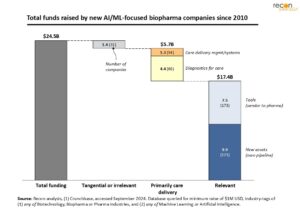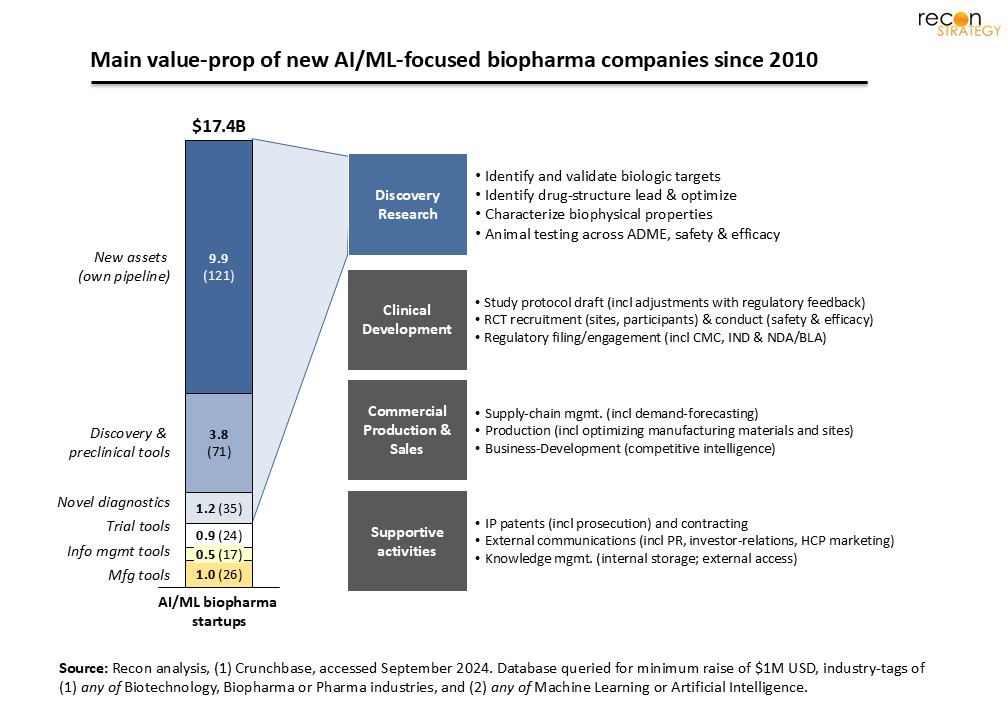“media attention [is] on lead identification, probably because it sells headlines” – Greg Meyers, Chief Digital and Technology Officer, BMS[1]
The biopharma industry is known for its high risk and potential high reward, but R&D costs have skyrocketed over the past century, delivering diminishing returns on investment. Despite breakthroughs, success rates remain low, and bringing a drug to market takes years. To combat this, the industry has continually adopted new tools, including crystallography, bioinformatics, robotics and high-throughput screening, all aimed at improving early-research efficiency and success rates.
The latest tool generating buzz is artificial intelligence (AI). By leveraging AI, companies hope to accelerate drug discovery and optimize the drug-candidates selected for development. Venture capital is flooding into AI-first biopharma startups, while established pharmaceutical companies are making significant AI investments of their own. However, AI’s true potential may extend far beyond early-research .
AI for Faster, Better Pipelines
There has been a massive surge of investment in AI, with both established and new biopharma firms building AI-tools into drug discovery approaches. While it is difficult to determine the total spend by existing biopharma on AI-platforms and vendors, several acquisitions and partnerships confirm appetite is robust. Just a couple of recent examples: Johnson & Johnson’s partnership with BigHat Biosciences in 2024[2] (for undisclosed payment) and BioNTech’s $440M acquisition of InstaDeep in 2023.[3]

What we can readily see is the number of newly-built companies, devoted exclusively to AI-driven drug research, that have launched and raised funding. A quick search of Crunchbase[4] helps us to understand the level of appetite – at least for new companies that are specifically listed in the biopharma industry. This approach has limitations: (1) it ignores the utility of many generalist-AI tools (e.g., Databricks) for biopharma; (2) the creation of life-science applications by non-biopharma firms (e.g., AlphaFold by Google); (3) the resources invested by established biopharma to build AI-tools exclusively for their internal teams. Despite these shortcomings, it is enlightening to see that Crunchbase lists over 450 companies (with over $24.5B raised) in both the AI- and biopharma industries. On closer inspection however, it is clear that only 294 companies (with over $17B raised) are truly biopharma firms – either possessing a pipeline of therapeutic assets or a life-science tool platform, per Figure 1. (Admittedly, this segmentation excludes many diagnostics firms, such as Tempus or Owkin, that sell clinical data to biopharma).
Perhaps unsurprisingly, these newly established companies nearly universally use-AI as a tool for pipeline (internal or external) creation. Only a smattering few (43 companies) focus their AI-tools for applications outside beyond pipeline creation (Figure2).

The Quieter Revolution: AI’s power beyond the pipeline
While investors are hyper-focused on AI for pipeline discovery, much more is required for success in biopharma. Beyond SG&A common to all large firms, numerous other activities require substantial resources and biopharma-expertise.
As established pharmaceutical companies adopt AI for pipeline development, they are also finding substantial value in applications well beyond R&D. These include clinical trial design, regulatory filings, supply chain optimization, and commercial production.
In clinical development, AI is already making an impact by optimizing processes that were once labor-intensive and time-consuming. For instance, Moderna’s CEO, Stéphane Bancel, explains how AI has dramatically streamlined regulatory work and accelerated dose selection:
“dose-selection to get into Phase 3, that process used to take around 60 days in a paper, computer world, with humans. But we basically built a bot, that for the last two products, has been telling us the dose (people still check by hand, they’re a bit scared about it) but that is done in literally 2 minutes….”
Regulatory interactions – both trial design and filings, have also benefited from AI advancements. Generative AI models, such as large language models (LLMs), are being used to create initial drafts of complex documents. Mike Nally, CEO of Generate Biomedicine, highlights the productivity boost:
“One of the things we’re spending a lot of time with, these LLM tools right now, on, is actually regulatory submissions and clinical protocols. LLMs are exceptional at creating a starting point. Now it can’t be unsupervised, they actually do act as a copilot, but it gives you the 80% rough draft almost immediately. That’s a huge productivity gain.”
Even in commercial operations, AI is playing a vital role. In 2023, Vertex’s Senior Director of Data & Advanced Analytics discussed ways his firm has used AI improve product monitoring and safety:
“[it] automatically converts a lot of our data, especially field service reports from medical service liaisons, to help us calculate sentiment for our medicines…. It helps us to identify any safety issues like over-prescription.”
These applications highlight the potential of AI beyond discovery – making drug development more efficient and ultimately increasing the returns on every launched product.
Lasting Impact AI
Historically, a disproportionate amount of transaction value in biopharma has been concentrated in “assets”—such as drug candidates—rather than in the platforms that generate these assets. This trend appears consistent in the current AI investment landscape, where venture capitalists predominantly invest in AI-driven biopharma ventures expected to own or develop tangible therapeutic assets. However, this focus on assets aligns with the highest levels of risk, as the process of bringing a drug to market remains lengthy and uncertain. VCs often prioritize these risk-heavy ventures, as the potential payoffs are be substantial. In contrast, investments in AI platforms or operational efficiencies (AI ops) are less likely to generate the kinds of multiple VCs seek.
However, the potential of AI to optimize clinical development, streamline regulatory processes, and improve commercial operations efficiency could offer substantial returns for the industry – and not surprisingly, established companies are looking to these tools to reshape operations well beyond discovery. Perhaps surprisingly, even for seemingly generic applications (e.g., knowledge management, legal contracts) these companies tend to opt for bespoke, internal-only, AI implementations. Beyond the ability to tailor the implementation to specific needs, this mitigates against the risk of leakage (wherein proprietary company data or IP is visible to competitors).
As AI continues to permeate all stages of drug development and commercialization, near-term the greatest impact on biopharma may well be outside of discovery. While these changes may be less visible than those in discovery, the gains will certainly still contribute to overall efficiency, and hopeful have a meaningful impact on the cost (and timelines!) to bring new drugs to market.
References
[1] Andrew Dunn, “Q&A: Bristol Myers’ tech chief on the promises and perils of AI bio”, Endpoints News, September 23, 2024.
[2] BigHat Biosciences Press Release, “BigHat Biosciences Enters Into Strategic Collaboration to Leverage Machine Learning in Antibody Discovery & Design” BusinessWire, April 24, 2024.
[3] BioNTech Press Release, “BioNTech Completes Acquisition of InstaDeep”, GlobeNewswire, July 31, 2023.
[4] Crunchbase, accessed September 2024.
[5] Interview on the Tegus platform.
